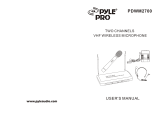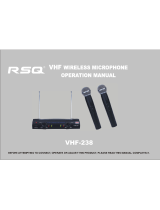
www.PyleUSA.com
www.PyleUSA.com
VHF WIRELESS SYSTEM
OPERATION MANUAL
Please read through these operating instructions so you will
know how to operate your model properly. After you have
nished reading the instructions, put them away in a safe
place for future reference.
CONTENTS
P1 Precautions
P2 Products Figure
P3 Hand-held Microphone
P4 Bodypack Transmitter
P5 Receiver Front panel
P6 Receiver Rear Panel
P7 Installation
P8 Troubleshooting
P9 Specications
PRECAUTIONS
• Avoid expose of the system to rain or moisture.
• No user-serviceable parts inside the system. Refer all servicing
to qualied Technician only
• Handle the wireless system carefully, dropping or other shocks
may cause failure
• Avoid using the system where it may be subjected to heat, such
as direct sunlight near radiators or other heat sources.
• Should any liquid be spilt on the arrangement, stop using it
immediately. It may be possible to dry the system, but you
should have it checked by a qualied technician before using it
again.
• Take upkeep with the main power transcriber and lead.
If damaged in any way,do not use the system and refer to a
qualied technician for repair.
• Only use the system with the supply components. Do not
attempt to use with any other main power provision adapter.
• If the wireless system is not going to be used for a while,
remove the battery to prevent leak. In the event of electrolyte
leak interior the battery compartment, carefully remove the
leakage with a damp material. Take care not to get battery
electrolyte in contact lens with your skin, however if it does,
washables your hands under a running strike. If electrolyte
comes into contact with your heart,seek medical advice
immediately.
• Only replace the battery with the same or an equivalent type.
• Please dispose of old batteries in an environmentally friendly
manner in accordance with the relevant legislation.
• Do not use and solvents to clean any part of the wireless system.
1 2
SYSTEM DIAGRAM
PDWM4300
PDWM4400










